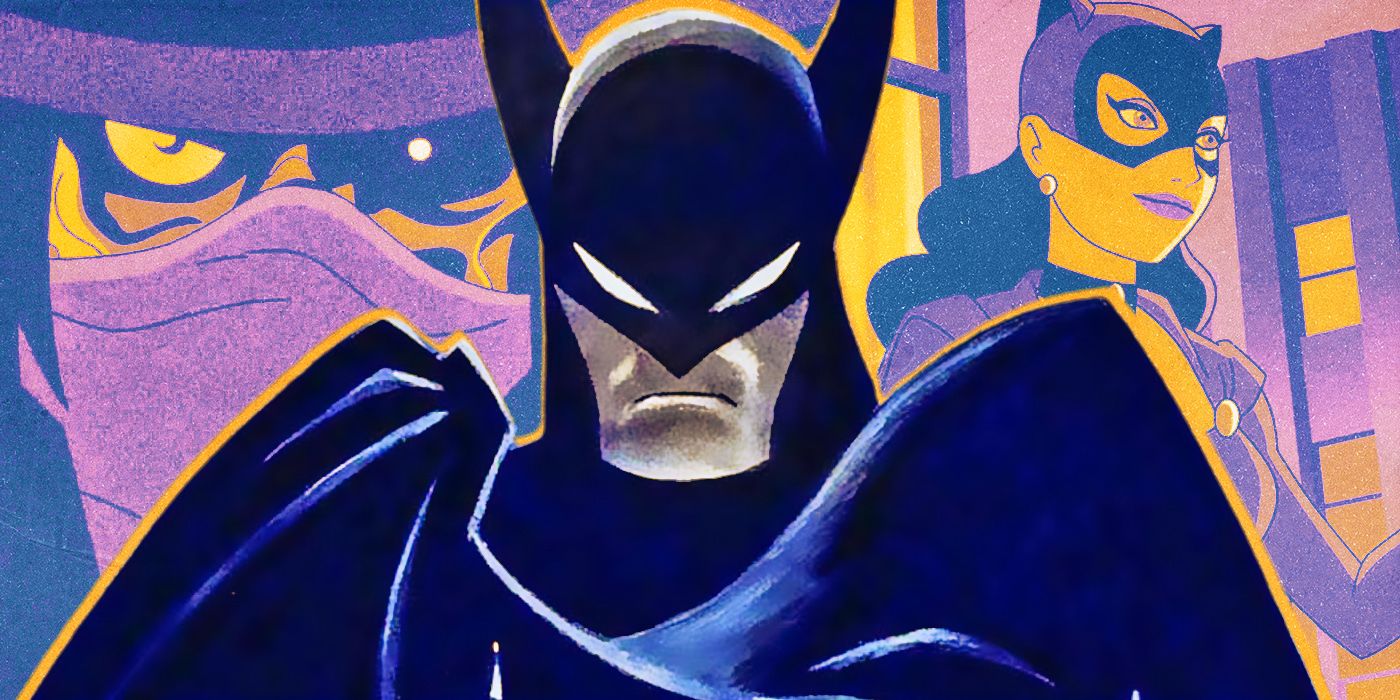[[{“value”:”
Summary
Characters like Catwoman and Alfred maintain Golden Age origins, while newer characters like Harley Quinn deviate from the original canon.
The show misses the mark by not truly adapting the Golden Age era of Batman, squandering the opportunity to explore lesser-known elements.
The following contains spoilers for Batman: Caped Crusader, now streaming on Prime Video.
Batman: Caped Crusader isn’t just another cartoon starring the titular DC Comics superhero. It’s a far more adult series compared to previous animated shows, and it also hearkens back to Batman’s adventures during the Golden Age of Comics. At the same time, it’s not nearly as much of an adaptation of this era as expected, for better or worse.
There are several concepts and characters in Batman: Caped Crusader that have nothing to do with the Golden Age, instead pulling from other eras of Batman comic books. Likewise, some of these cast members have nothing to do with Batman at all, instead hailing from other parts of the DC Universe. While this keeps things fresh and gives unique perspectives to classic characters, it misses out on adapting one of the most overlooked periods for Batman.
Most of Batman: Caped Crusader Superficially Resembles the Golden Age
Catwoman and Harley Quinn Take Center Stage in Batman: Caped Crusader Video
“What can I say? I like nice things.” Catwoman and Harley Quinn take center stage in a Batman: Caped Crusader video.
For the most part, Batman: Caped Crusader has at least the veneer of the Golden Age of Comics, from the time period to other elements. The show is seemingly set in some version of the 1940s, even if it doesn’t truly match up with how American society was in that time. Batman’s design resembles his Golden Age iteration, namely with his suit having longer, almost horn-like ears. While he has gadgets, they aren’t the apex of technology and fit within the confines of the show’s time period.
There’s also a general seediness that fits the noir setting, which itself was derived from the pulp novels that inspired the character’s debut in the late 1930s. Most of the characters appearing in the series also had their debuts in the Golden Age. Beyond Batman himself, this includes Catwoman/Selina Kyle, The Joker (who’s seen in Caped Crusader’s Season 1 finale), Dick Grayson (who has essentially a cameo and isn’t Robin), Commissioner Gordon, Bruce’s flame Julia Madison and Alfred Pennyworth, the latter of whom is portrayed as being large like in the Golden Age.
Even the red car that Bruce drives is a Golden Age homage, as this was essentially the predecessor in the comics to the true Batmobile. Add in the general tone of the show, and it feels right at home with that time period, which is what was promised. At the same time, there are notable differences from the established canon, namely through other aspects seen in Batman: Caped Crusader.
Batman’s Newest Cartoon Also Has Aspects of Silver Age and Modern Comics
Batman: Caped Crusader’s Radiacally Reimagined Villian Is The Scariest Incarnation Yet
Batman: Caped Crusader has a number of surprises for fans. That includes a classic villain, who’s been reinvented as scarier than they’ve ever been.
The Golden Age isn’t the only era of Batman comic books that’s utilized as source material in Batman: Caped Crusader. For instance, even though Catwoman debuted in the Golden Age, and she wears her Golden Age costume in the show, she has the origin of Silver Age Catman. While Alfred also resembles his Golden Age iteration, he actually has his usual last name of Pennyworth instead of his original last name (Beagle). A similar change happens to Two-Face, who has his usual real name of Harvey Dent instead of the original Harvey Kent. The Penguin appears in Batman: Caped Crusader, but the villain is changed to be female.
Likewise, as noted, Dick Grayson is present in the series, but he never becomes Robin and seemingly has a much different backstory. Similarly, the other versions of Robin from the comics are seen in the form of orphan children named Jason, Carrie and Stephanie. These later Robins debuted in the Bronze Age and Dark Age of Comics, long after the Golden Age ended. Other examples of these are Arnold Flass, Harvey Bullock, Renee Montoya and the heavily altered Harley Quinn, who either debuted in much later comics or in the 1990s Batman: The Animated Series.
Another Bronze Age addition was Nocturna, a young girl whose real name was Natalia. She’s also changed to be essentially a vampire, a function that could have been fulfilled by actual Golden Age villain Dala. Similarly, Barbara Gordon was a Silver Age character, and her role as a lawyer was a Bronze Age development. Even Gordon’s appearance (despite his ethnicity being changed) resembles his more modern appearance than how he looked in the Golden Age. Killer Croc is briefly seen and Deadshot is mentioned, with both of these villains being from the Bronze Age. While the Gentleman Ghost (who’s in the show’s sixth episode) debuted in the Golden Age, he’s a Hawkman villain and not tied to Batman whatsoever.
The same is the case with Onomatopoeia, who appeared in the 2000s comics as an enemy of Green Arrow. Even Clayface is (like his appearance in Batman: The Animated Series) a fusion of Golden Age Clayface Basil Karlo and Silver Age iteration Matt Hagen. Conversely, the show brings in an almost completely forgotten Bronze Age villain named Firebug in one episode, though Flass and Bullock keep referring to him as Firefly (who debuted in the “Atomic Age,” between the Golden and Silver Age). With all these changes and other sources, it’s clear that Batman: Caped Crusader isn’t truly an adaptation of the Golden Age at all.
Batman: Caped Crusader Is a Major Missed Opportunity
Batman: Caped Crusader Reveals Gender-Swapped Penguin Voiced by Minnie Driver
A first look has been revealed for the gender-swapped Penguin in Batman: Caped Crusader.
The announcement of another Batman cartoon — even one that involved Batman: The Animated Series creator Bruce Timm and The Batman director Matt Reeves — was somewhat hard to parse. More than any DC character, The Dark Knight has had an onslaught of non-stop adaptations, making another cartoon for the superhero much less than an exciting new idea. Nevertheless, fans became interested when it became clear that the show was going to draw from the Golden Age of Comics. In the end, however, that’s not really the case, and it becomes evident that this old-school veneer was more of a stylistic choice than anything else. Batman: Caped Crusader is barely anymore “Golden Age” than Batman: The Animated Series, which itself already shared the old-school film noir aesthetic.
Beyond the lack of modern technology or computers, the shows feel as if they’re in essentially the same world, with even 1940s colloquialisms being few and far between. If anything, the retro vibe did little more than give lip service to the Golden Age and that real-life period without being accurate to either. Batman’s Golden Age comic books are some of the most overlooked aspects of his history. While the introduction of Robin did arguably prematurely push things a bit closer to the goofy tone of the Silver Age (compared to the Golden Age Superman comics, which kept their degree of grittiness a lot longer), this was still a distinct incarnation compared to what came next.
Even the comic books have rarely gone back and looked at this period, with the recent and excellent Black Label series The Bat-Man: First Knight being a notable exception. Given that it hasn’t really been explored much, despite the character’s ubiquitous nature, it’s a shame that the new series squanders the chance to do so. This is especially the case given the caliber of creators involved, as they could have easily shone a light on these more obscure Batman elements. As noted, the character Nocturna was used when Golden Age villain Dala would have made much more sense given the supposed scope of the series.
Dala has rarely been used even in the comics, so giving her and similar foes from that era the spotlight could have helped make them as mainstream as other members of Batman’s rogues gallery. This was honestly needed, as many of the alterations made to Batman’s villains in order to seem “fresh” instead fell completely flat, especially the series’ new take on Harley Quinn. Likewise, given how large Batman’s list of enemies is, there was even less need to include characters from Hawkman and Green Arrow’s rogues galleries. Overall, Batman: Caped Crusader is a more than worthy new addition to the character’s stable of animated masterpieces, but it misses the mark on occasion by not actually being what it was marketed as.
Batman: Caped Crusader is now streaming on Prime Video.
“}]] Batman: Caped Crusader takes a lot from the character’s Golden Age comics, but many aspects from the new show adapt other parts of his history. Read More

